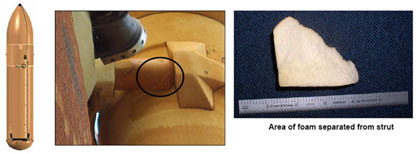NASA weighs new shuttle foam problem
(AP)
Updated: 2006-07-04 06:49
NASA wrestled Monday with whether to try a Fourth of July space shuttle
liftoff after the startling discovery of a small chunk of foam insulation that
broke off Discovery's fuel tank as it sat on the launch pad.
The troubling find came after inspectors discovered a 5-inch-long crack
in the foam, a problem that continues to vex NASA ever since a big piece of foam
brought down Columbia and killed seven astronauts in 2003.

A graphic from NASA
shows the external fuel tank, close-up of the lock speedline bracket
showing an area of missing foam and a photo of the missing chunk of foam
from space shuttle Discovery's external fuel tank in Cape Canaveral July
3, 2006. [Reuters] |
NASA managers were
meeting Monday evening to decide how to tackle the problem and whether a Tuesday
launch was possible.
At least one member of the panel of experts that investigated the Columbia
accident said he was nervous about the decision.
"If those guys aren't more nervous than I am, they've become jaded and should
resign their positions," said Nobel Prize-winning physicist Douglas Osheroff.
But two of Osheroff's accident board colleagues said they were comfortable, with
board chairman Harold Gehman Jr. saying, "It looks to me like they are following
the right decision processes."
NASA managers are leaning toward flying Discovery with no changes to the foam
section in question, said John Chapman, external tank project manager.
The other options were to spend a day inspecting the foam area of
concern, which would push the launch back to Wednesday, or to try to fix the foam, which
would take several days and require NASA to use a new technique since such a
repair has never been done in that area before, Chapman said.
"We believe we're getting much more comfortable with the ability to
potentially fly as we are right now, but the team is still looking at that,"
Chapman said. "We want to make sure that we understand all the considerations
that caused this foam to be lost."
The 3-inch-long, triangle-shaped piece fell off an area of foam that covers
an expandable bracket holding a liquid oxygen fuel line against the huge
external tank. NASA engineers believe ice built up in that area from
condensation caused by rain Sunday.
|